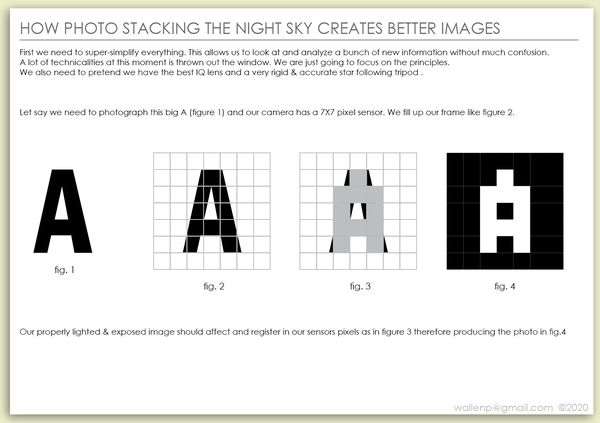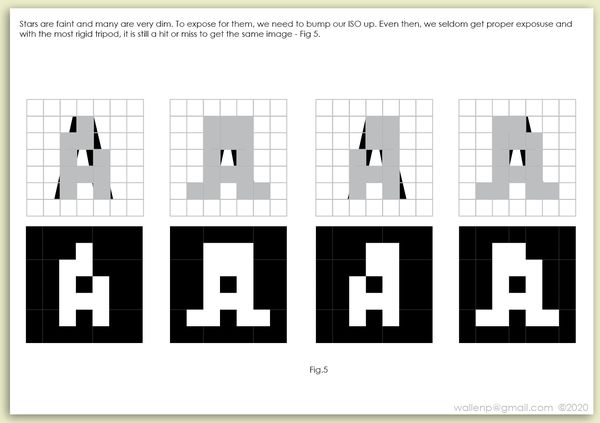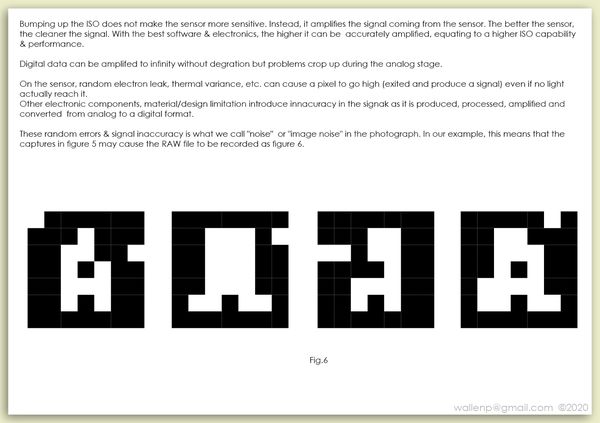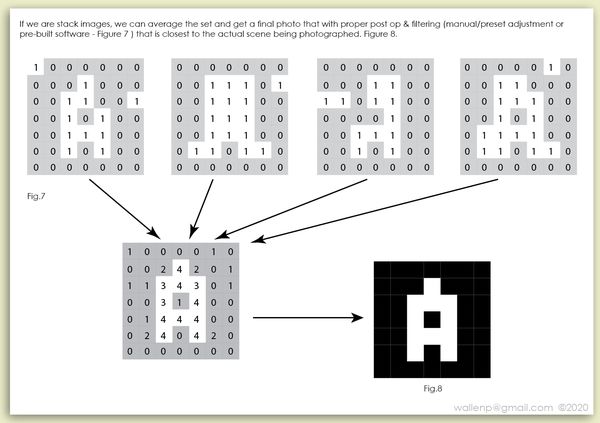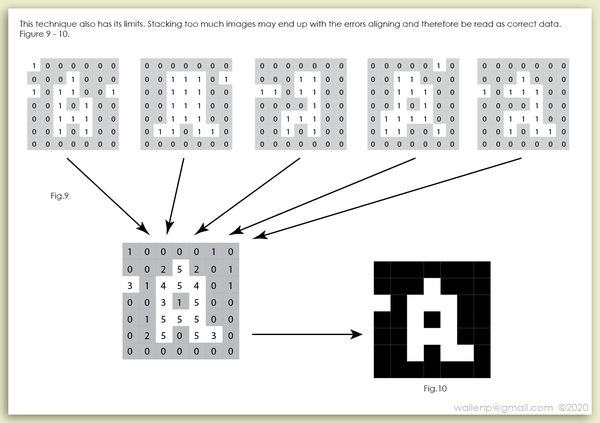How stacking improves a Photograph
Mar 25, 2020 04:05:38 #
A simplified explanation on how stacking images improves over a single photo.
Although the below mainly tackles under exposed star photos, the same principle applies to Focus Stacking, Bracketing, HDR & Long Exposure with each set on manipulating their target area of improvement or change.
Although the below mainly tackles under exposed star photos, the same principle applies to Focus Stacking, Bracketing, HDR & Long Exposure with each set on manipulating their target area of improvement or change.
Mar 25, 2020 06:03:10 #
Mar 25, 2020 06:20:48 #
Tomfl101 wrote:
Yeah that really clarify’s,it for me 🤷🏼🤷🏼🤷🏼♂️
On the 2nd panel, when we took photos of the "A" we got 4 inaccurate results, because of the inability of our camera to expose properly.
On the 3rd panel, those exposures when finally written were also changed by the inaccuracy of the camera software and by the limitations of the sensor itself.
On the fourth panel, every pixel is given a value of 1 or none. Then these are collated precisely on top of one another and the values of each pixel added, we get values of zero to four as a result. Using a filter, we use only the upper half of the average 3 & 4 and that replicated the correct image from the 4 incorrect ones.
This is the how we can get cleaner images by stacking multiple exposure. Since noise is a random part in the image, it tends to cancel/even out while the correct image is steadily enhanced by multiple layers adding the same bit of data or for a more technical explanation, increasing the signal to noise ratio.
On the fifth panel, because some of the errors aligned, we reach the point of diminishing returns. The same filtering fails to produce the correct image and the final output has 2 extra lighted pixel. In actual practice, such extra pixels will appear as noise, smudges or blending. Those in another circumstance form soft edges, ghost images or dreamy waterfalls when doing a long exposure.
Mar 25, 2020 07:16:45 #
Now I have it as straight as a pretzel and everything is clear as thick mud.
I'll just take your word for it. Having seen stacked photos compared with single photo macro shots, I can see there is a big difference and stacking works.
I'll just take your word for it. Having seen stacked photos compared with single photo macro shots, I can see there is a big difference and stacking works.
Mar 25, 2020 07:56:51 #
PhotogHobbyist wrote:
Now I have it as straight as a pretzel and everything is clear as thick mud.
I'll just take your word for it. Having seen stacked photos compared with single photo macro shots, I can see there is a big difference and stacking works.
I'll just take your word for it. Having seen stacked photos compared with single photo macro shots, I can see there is a big difference and stacking works.

Mar 25, 2020 08:20:19 #
The issue with this sample is that it uses a excessively small subject and does muddy the waters unless one is able to transcend the illustration.
It would have been better to just say that stacking uses the (mean) average pixel values after aligning and blending several images.
Sometime we try too much to explain something in detail and lose our audience even if the explanation and illustration are correct.
It would have been better to just say that stacking uses the (mean) average pixel values after aligning and blending several images.
Sometime we try too much to explain something in detail and lose our audience even if the explanation and illustration are correct.
Mar 26, 2020 07:38:33 #
ggab
Loc: ?
Rongnongno wrote:
The issue with this sample is that it uses a excessively small subject and does muddy the waters unless one is able to transcend the illustration.
It would have been better to just say that stacking uses the (mean) average pixel values after aligning and blending several images.
Sometime we try too much to explain something in detail and lose our audience even if the explanation and illustration are correct.
It would have been better to just say that stacking uses the (mean) average pixel values after aligning and blending several images.
Sometime we try too much to explain something in detail and lose our audience even if the explanation and illustration are correct.
ZZZZZZZZZZZzzzzzzzzzzzzzzzzzzzzz......................

Mar 26, 2020 08:55:00 #
Mar 26, 2020 09:05:46 #
Mar 26, 2020 09:22:51 #
Mar 26, 2020 10:12:30 #
I think I get it. When stacking is done with an optimal number of source pictures in astrophotography, you get an image with less sensor noise. One may claim that noise reduction in post-processing would do the trick as well, as it works to blend out isolated bright pixels, but in that form of photography the subjects are also isolated bright pixels. So noise reduction would also remove some stars. But getting a cleaner image in the first place, using this method, helps to avoid that effect.
The suggestion here is that stacking or otherwise merging pictures on down-to-earth subjects might provide a similar benefit. Only here it would apply only if the source pictures were not focus bracketed but instead were taken at the same focal point. The resulting combined image might preserve truer details without noise. It's beyond my pay grade to interpret if this is true, but its an interesting thought.
The suggestion here is that stacking or otherwise merging pictures on down-to-earth subjects might provide a similar benefit. Only here it would apply only if the source pictures were not focus bracketed but instead were taken at the same focal point. The resulting combined image might preserve truer details without noise. It's beyond my pay grade to interpret if this is true, but its an interesting thought.
Mar 26, 2020 10:34:17 #
Mar 26, 2020 10:37:22 #
Reminds of a friend of mine: ask him what time it is and he tells you how to build a watch.
And to the op: no offense intended. You obviously know what you’re doing👍
And to the op: no offense intended. You obviously know what you’re doing👍
Mar 26, 2020 11:14:53 #
Rongnongno wrote:
The issue with this sample is that it uses a excessively small subject and does muddy the waters unless one is able to transcend the illustration.
It would have been better to just say that stacking uses the (mean) average pixel values after aligning and blending several images.
Sometime we try too much to explain something in detail and lose our audience even if the explanation and illustration are correct.
It would have been better to just say that stacking uses the (mean) average pixel values after aligning and blending several images.
Sometime we try too much to explain something in detail and lose our audience even if the explanation and illustration are correct.



Mar 26, 2020 11:24:46 #
Seems all the stackings are helpful and amazing innovations in today's cameras. You can increase the #of pixels with image stacking, increase the dynamic range with exposure stacking (HDR), increase the depth of focus with focus stacking, increase the focal abilities with side-ways or vertical pano-stitching, get telephoto type compression and wider angle with vertical & horizontal image stitching to make one final frame. Put all these in one mirrorless camera with IBIS that works with lens VR, and you have a thoroughly modern camera.
If you want to reply, then register here. Registration is free and your account is created instantly, so you can post right away.

